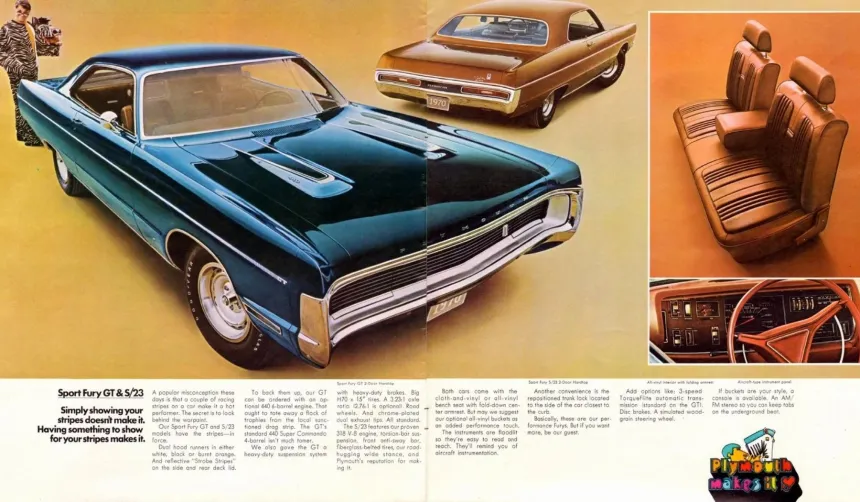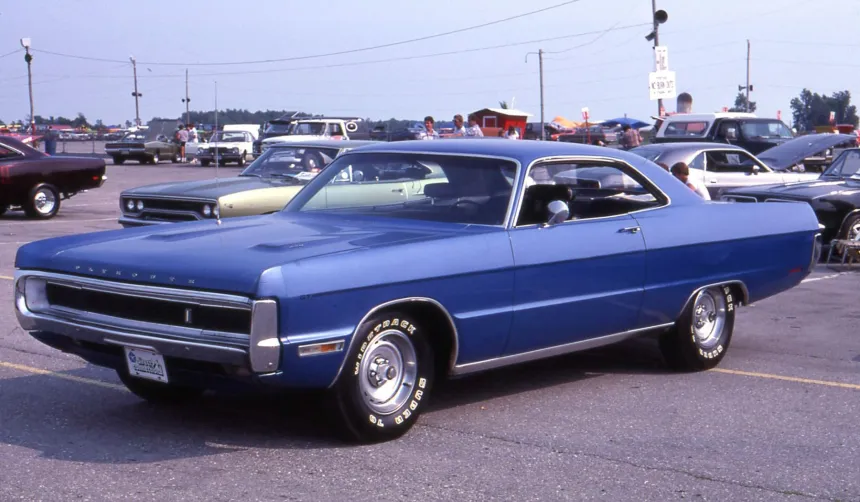With its bold appearance and powerful V8 engine, the Plymouth Sport Fury GT represented the peak of luxury full-size coupes combined with muscle car performance in the 1970 and 1971 model years.
Long before American automakers began offering high-powered intermediates, pony cars, and compacts, the most powerful V8 engines were found in each brand’s full-size models.
In 1964, Pontiac took its strongest full-size V8 and placed it in the mid-size LeMans, creating the GTO performance package.
The GTO became an immediate success, and with its sales soaring, other manufacturers quickly followed suit.
In just a few years, performance enthusiasts began favoring smaller wheelbase models, leading automakers to phase out high-performance full-size cars.
Plymouth made a surprise move in 1970

By then, the list of full-size coupes with muscle car powertrains was limited. Chevy had dropped the SS package for the Impala, Pontiac phased out the 390-hp 428 HO V8, and the 455 offered in its full-size models lacked excitement.
For those few still interested in a performance-focused full-size car in 1970, Mercury reintroduced the Marauder X-100, while Chrysler released the limited-edition 300 Hurst.
Despite the apparent lack of demand for such cars, Plymouth, which was thriving with its popular Road Runner and preparing to launch a completely redesigned Barracuda, chose to enhance its performance lineup with a new package for the Sport Fury two-door hardtop coupe.
Named GT, the package added some visual flair to the Sport Fury and, more importantly, offered two powerful big-block V8s along with several chassis upgrades.
The Executive Supercar

When selecting the GT package (A52) on the order sheet, buyers received a Sport Fury that Plymouth dubbed “The Executive Supercar.”
The 1970 Sport Fury, with its fuselage-style two-door hardtop body and hidden headlamps, was impressive even in its base form.
The GT package made it more striking by adding wider Rallye wheels with Goodyear Polyglas white-letter tires, dual exhausts, subtle side and hood stripes, and the option to choose from High Impact colors.
To match its “Executive Supercar” label, the Sport Fury GT also offered a refined interior. The standard cabin featured a vinyl-upholstered bench seat with a foldable armrest, but individual bucket seats were available as an option.
The GT package returned for 1971, though with no major visual changes. The only noticeable updates were a slightly redesigned hood without the dual bulges and a new front grille.
Big-block power

Built on the large C-body platform with a 120-inch (3,048 mm) wheelbase, the Sport Fury GT weighed around 4,200 pounds (1,905 kg), requiring a powerful engine to match its performance.
For 1970, the standard engine in this large muscle car was a 440-ci (7.2-liter) Commando V8. With a four-barrel carburetor, high-flow cylinder heads, and a high-performance intake manifold, this big-block V8 produced 350 hp and 480 lb-ft (651 Nm) of torque.
Paired with a TorqueFlite 727 three-speed automatic transmission, the Commando engine was powerful but not quite enough to make the GT a true full-size supercar. As a result, Plymouth offered an additional engine option.
The optional engine was also a 440-ci (7.2-liter) RB, but it featured a set of three two-barrel Holley carbs. Known as the Six-Barrel (or Six-Pack in Dodge models), this engine delivered 390 hp and 490 lb-ft (664 Nm) of torque, making it a favorite among Mopar enthusiasts for its performance, particularly in muscle cars like the Road Runner.
However, for the 1971 model year, the Six-Barrel was discontinued, and the only available big-block V8 for the Sport Fury GT was the 375-hp 440, also known as the Super Commando.
A solid performer

In addition to the powerful 440 big-block V8s, the ’70-’71 Sport Fury GT featured a heavy-duty suspension system with a reinforced front roll bar, heavy-duty drum brakes, and a durable rear end with suitable ratios.
Given the available rear-end ratios and its substantial weight, the Plymouth wasn’t built for dragstrip dominance.
However, magazine tests showed the Six-Barrel-equipped Sport Fury GT could run a quarter-mile in the low 16-second range at 92 mph (148 kph), making it a strong performer for its class.
The top-tier Fury was essentially a heavyweight luxury cruiser with a significant muscle car edge, providing an enjoyable ride on highways with little to no traffic.
Extremely rare

Plymouth took a risk with a car in a segment that was no longer in demand, doing so for two consecutive model years.
As expected, the Sport Fury GT didn’t follow the success of its Road Runner sibling and became a sales failure.
In 1970, Chrysler sold just over 660 units, with an estimated 60 of those equipped with the Six Barrel 440 engine.
The following year was even worse, with only 375 GTs sold.
Today, the Sport Fury GT is nearly forgotten, despite being an impressive high-performance land yacht and the last of its kind from the muscle car era.
Multiple sources report that fewer than 100 original Sport Fury GTs remain, making it an extremely rare model.

